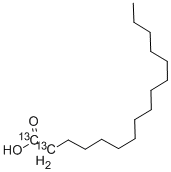Palmiticacid-1-(13C) , 99atom%13C , 57677-53-9
Synonym(s):
Hexadecanoic acid-1-13C
| Pack Size | Price | Stock | Quantity |
| 250mg | RMB559.20 | In Stock |
|
| 1g | RMB601.60 | In Stock |
|
| others | Enquire |
PRODUCT Properties
| Melting point: | 61-64 °C(lit.) |
| Boiling point: | 271.5 °C100 mm Hg(lit.) |
| Density | 0.855 g/mL at 25 °C |
| storage temp. | Store at -20°C |
| solubility | DMF: 20 mg/ml; DMSO: 20 mg/ml; Ethanol: 30 mg/ml; Ethanol:PBS (pH 7.2) (1:2): 0.25 mg/ml |
| form | A solid |
| color | White to off-white |
Description and Uses
Palmitic acid-13C is intended for use as an internal standard for the quantification of palmitic acid by GC- or LC-MS. Palmitic acid is a common 16-carbon saturated fat that represents 10-20% of human dietary fat intake and comprises approximately 25 and 65% of human total plasma lipids and saturated fatty acids, respectively. Acylation of palmitic acid to proteins facilitates anchoring of membrane-bound proteins to the lipid bilayer and trafficking of intracellular proteins, promotes protein-vesicle interactions, and regulates various G protein-coupled receptor functions. Red blood cell palmitic acid levels are increased in patients with metabolic syndrome compared to patients without metabolic syndrome and are also increased in the plasma of patients with type 2 diabetes compared to individuals without diabetes.
Hexadecanoic-1-13C Acid is a labeled analog of Palmitic Acid (P144500), which is a common fatty acid found in plants and animals. The body converts excess carbohydrates into Palmitic Acid, thus Palmitic Acid is the first fatty acid produced during fatty acid synthesis as well as a precursor for longer fatty acids.
Safety
| Symbol(GHS) |  GHS07 |
| Signal word | Warning |
| Hazard statements | H315-H319-H335 |
| Precautionary statements | P261-P305+P351+P338 |
| Hazard Codes | Xi |
| Risk Statements | 36/37/38 |
| Safety Statements | 26-36 |
| WGK Germany | 3 |





